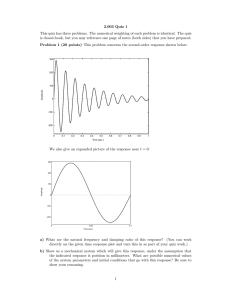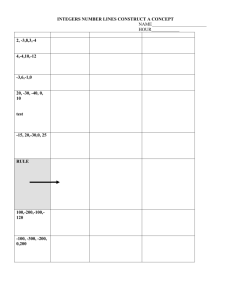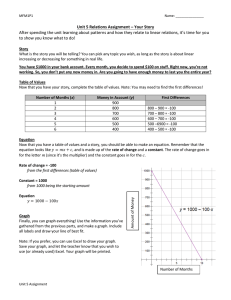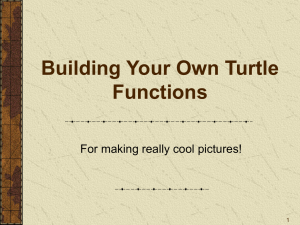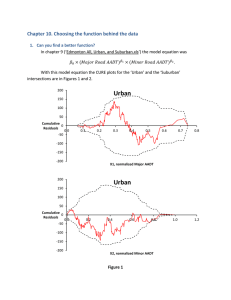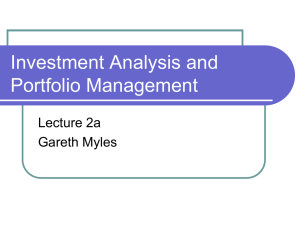Transient Voltage Surge Suppression Design and Correlation Marcus O Durham, PhD, PE
advertisement
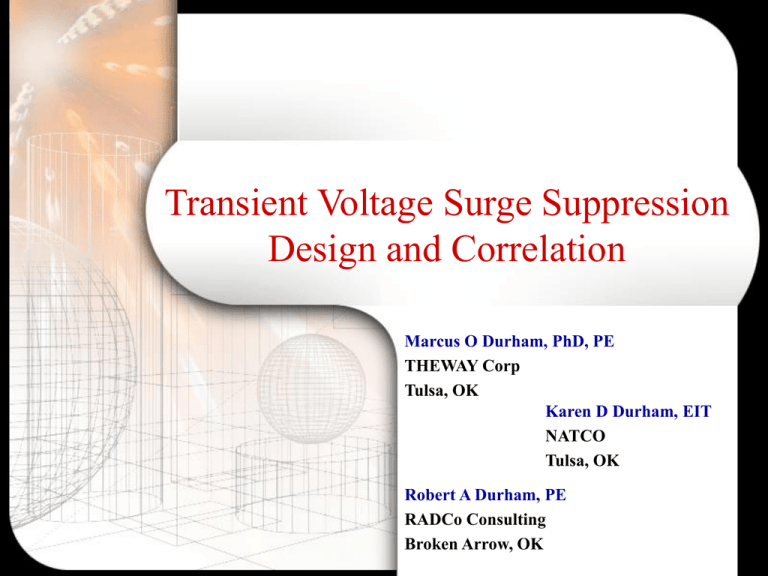
Transient Voltage Surge Suppression Design and Correlation Marcus O Durham, PhD, PE THEWAY Corp Tulsa, OK Karen D Durham, EIT NATCO Tulsa, OK Robert A Durham, PE RADCo Consulting Broken Arrow, OK Introduction • Most protection consists of traditional arresters • Most devices remain un-validated for app • Cost of inadequate protection – Equipment failure – Downtime – lost revenue • Proper protection improves bottom line Introduction • • • • Components and systems tested Custom designs evaluated Design approaches discussed Cost vs. protection evaluated ANSI Standard Tests • Tests conducted according to ANSI C62.1 procedures • Open circuit (voltage) evaluated using 1.2/50 wave shape • Short circuit (current) evaluated using 8/20 wave shape ANSI C62.1 Waveforms 1000 500 800 400 100 200 0 0 -100 0 10 20 30 -200 40 1.2 / 50 wave-shape 500 500 400 400 300 300 200 200 100 100 0 0 -100 -100 -10 0 10 20 30 8 / 20 wave-shape -200 40 Amps -200 -10 Volts Volts 200 400 Amps 300 600 Protection Devices • Chosen based on system conditions – – – – • Only a few types available – – – – Voltage Frequency Exposure Grounding Physical Separation Ceramic Materials Passive Devices Solid State Components V I Shunt current F Filter frequencies Clamp voltage E Block energy Protection Devices Observations • Test signal - impulse Power systems - RMS • Vpeak = 2 * VRMS • Most devices do not operate until 2*Vrated 500 500 400 400 300 300 200 • Let-through voltage often 22 * Vrated 200 100 100 0 0 -100 -200 -100 -10 0 10 20 30 120V Gas Tube Response 40 Passive Elements Capacitors • • • • Shunt voltage to ground Store Energy Size Dissipation Hold elevated voltage on line 500 500 400 400 300 300 200 200 100 100 0 0 -100 -100 -200 -10 0 10 20 30 Capacitor Response 40 Passive Elements Inline Devices • • • • • Resistance is consideration 4-20 ma loop compliance = 600 max Must be small enough to not impact ops Must be large enough to limit current Must have large enough power rating Passive Elements Inductors • Block current changes • Size Voltage buildup • Induce higher V due to I changes V = L di/dt • Air core preferred 1000 500 400 800 300 600 200 400 100 200 0 0 -100 -200 -200 -10 0 10 20 30 Inductor Response 40 Filters • • • • Made of inline inductor and shunt capacitor Must pass 60 Hz for power system Transients look like 1MHz signal Resonance will occur at some point • Filters not generally recommended 1000 500 400 800 300 600 200 400 100 200 0 0 -100 -200 -200 -10 0 10 20 30 Filter Response 40 Semiconductors • • • • Fast, handle less energy MOV = Zinc Oxide = Voltage I = kV SiC = 10 ZnO = 25 - 60 • Hi W = Hi C Hi Z @ Hi f 500 500 400 400 300 300 200 200 100 100 0 0 -100 -100 -200 -10 0 10 20 30 Semiconductor Response 40 Semiconductors • • • • Diodes fastest, but have low power rating Couple with gas tube to increase rating MOVs have highest power rating Still must be coupled with secondary device MOV Grounds • Uniform equi-potential ground is most effective protection • Generally, single point connection • Isolated @ source for hi energy • Isolated @ load for remote instrumentation Instrumentation TVSS • • • • Most common are inline devices Problem with Z and f response Commercial use common mode Problem with remote app (circulating I) xmitter + _ + _ s xmitter + _ s Isolated Signal Ground + _ Remote Instrumentation TVSS • Isolate transmitter and DCS • Use differential mode MOVs • Use inline inductors for isolation • Inductors round the curve • Dissipates energy w/o ground 500 500 400 400 300 300 200 200 100 100 0 0 -100 -100 -200 -10 0 10 20 30 40 Remote TVSS Response Power TVSS • Shunt type adequate • Inline devices – Failed or – Ineffective in performance or packaging – Most had more output V than input V • Hard to match f response and low Z • Often L-N adequate, while L-G worsened Power TVSS Response 500 500 400 400 300 300 200 200 100 100 0 0 -100 -100 -200 -10 0 10 20 30 1000 500 40 400 800 L-N Response 300 600 200 400 100 200 0 0 -100 -200 -200 -10 0 10 20 30 L-G Response 40 Power TVSS • Highly sophisticated design – – – – MOV, Gas tube and capacitor L-N @ input Fe core inductor inline MOVs L-N, L-G, N-G @ output Transorb L-N @ output • Output V slightly higher than other MOVs • Handles more energy • Ringing less due to transorb Motor TVSS 480 Volt • • • • Complete system with filters 6000 V L-N & G input 5900V pass-through Grounds shorted ringing on output R load harmonic spikes every 10 S • MOVs as effective • Primary arresters enhance MOV response TVSS Challenges • Follow-through – Gas tube – MOVs – Diodes • Degradation – Select device w/ lifetime hit rating>100,000 • Catastrophic failure – Shorted @ life or overpowered – Open with very excessive power (melts) Conclusions - General • The engineer with information is never at the mercy of opinions. • Proper application of protection should be based on tested performance • Response to standard waveforms can be used to determine circuits of proprietary units Test Device 1Open Circuit 2Open Circuit 3Short Circuit Rating Units Test Peak Min V Peak Min I Peak V Voltage V I Out 1000 1011 8 11 4 1000 1009 3 13 -6 1000 99 -4 458 -31 Conclusions - Components • Most devices do not provide substantial protection until 200% rated voltage • Inductors can create Vout >> Vin • Filters resonate at some transient frequency • Higher energy devices tend to be slower • Semiconductor devices need primary arrester to handle hi energy Conclusions - TVSS • Remote systems should dissipate energy without ground • Power inline devices failed or did not provide proper protection • More sophisticated circuits did not provide additional protection • Most effective protection is proper grounding system Questions ?
